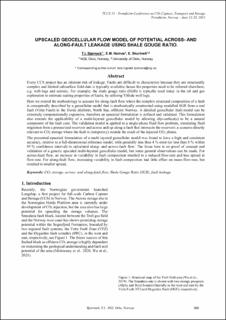| dc.contributor.author | Bjørnarå, T.I. | |
| dc.contributor.author | Haines, E.M. | |
| dc.contributor.author | Skurtveit, E. | |
| dc.date.accessioned | 2021-09-30T09:29:40Z | |
| dc.date.available | 2021-09-30T09:29:40Z | |
| dc.date.issued | 2021 | |
| dc.identifier.isbn | 978-82-536-1714-5 | |
| dc.identifier.issn | 2387-4295 | |
| dc.identifier.uri | https://hdl.handle.net/11250/2786524 | |
| dc.description.abstract | Every CCS project has an inherent risk of leakage. Faults are difficult to characterize because they are structurally complex and limited subsurface field-data is typically available; hence the properties need to be inferred elsewhere, e.g. well-logs and seismic. For example, the shale gouge ratio (SGR) is typically used today in the oil and gas exploration to estimate sealing properties of faults, by utilizing VShale well logs.
Here we extend the methodology to account for along-fault flow where the complex structural composition of a fault is conceptually described by a geocellular model that is stochastically constructed using modelled SGR from a real fault (Vette Fault) in the Horda platform, North Sea, offshore Norway. A detailed geocellular fault model can be extremely computationally expensive, therefore an upscaled formulation is defined and validated. This formulation also extends the applicability of a multi-layered geocellular model by allowing slip-surface(s) to be a natural component of the fault core. The validation model is applied to a single-phase fluid flow problem, simulating fluid migration from a pressurized reservoir and across and up along a fault that intersects the reservoir; a scenario directly relevant to CO2 storage where the fault is (temporary) outside the reach of the injected CO2 plume.
The presented upscaled formulation of a multi-layered geocellular model was found to have a high and consistent accuracy, relative to a full-dimensional reference model, with generally less than 4 % error (or less than 8 % within 95 % confidence interval) in calculated along- and across-fault flow. The focus here is on proof of concept and validation of a generic upscaled multi-layered geocellular model, but some general observations can be made. For across-fault flow, an increase in variability in fault composition resulted in a reduced flow-rate and less spread in flow-rate. For along-fault flow, increasing variability in fault composition had little effect on mean flow-rate, but resulted in smaller spread. | en_US |
| dc.language.iso | eng | en_US |
| dc.publisher | SINTEF Academic Press | en_US |
| dc.relation.ispartof | TCCS–11. CO2 Capture, Transport and Storage. Trondheim 22nd–23rd June 2021.
Short Papers from the 11th International Trondheim CCS Conference | |
| dc.relation.ispartofseries | SINTEF Proceedings;7 | |
| dc.rights | CC BY 4.0 | * |
| dc.rights.uri | https://creativecommons.org/licenses/by/4.0/ | * |
| dc.subject | CO2 Storage | en_US |
| dc.subject | Across- And Along-Fault Flow | en_US |
| dc.subject | Shale Gouge Ratio (SGR) | en_US |
| dc.subject | Fault Leakage | en_US |
| dc.title | Upscaled Geocellular Flow Model of Potential Across-and along-Fault Leakage Using Shale Gouge Ratio | en_US |
| dc.type | Chapter | en_US |
| dc.type | Peer reviewed | en_US |
| dc.type | Conference object | en_US |
| dc.description.version | publishedVersion | en_US |
| dc.rights.holder | © 2021 The Authors. Published by SINTEF Academic Press. | en_US |
| dc.subject.nsi | VDP::Teknologi: 500 | en_US |

